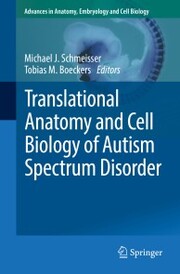Detailansicht
Translational Anatomy and Cell Biology of Autism Spectrum Disorder
eBook - Advances in Anatomy, Embryology and Cell Biology
ISBN/EAN: 9783319524986
Umbreit-Nr.: 4501721
Sprache:
Englisch
Umfang: 0 S., 4.59 MB
Format in cm:
Einband:
Keine Angabe
Erschienen am 25.05.2017
Auflage: 1/2017
E-Book
Format: PDF
DRM: Digitales Wasserzeichen
- Zusatztext
- Autism spectrum disorder (ASD) affects approximately 1 % of the human population and is characterized by a core symptomatology including deficits in social interaction and repetitive patterns of behaviour plus various co-morbidities. Although a lot of progress has been made to uncover underlying causes and mechanisms throughout the last decade, we are still at the very beginning to understand this enormously complex neurodevelopmental condition. This special volume is focused on translational anatomy and cell biology of ASD. International experts from the field including several members of the EU-AIMS initiative launched by the European Union to develop novel treatments for ASD have contributed chapters on several topics covering all crucial aspects of translational ASD research with a special emphasis on ASD model systems including stem cells and animals. Primary objective is to clarify how anatomical and cell biological phenotypes of ASD will help to translate basic mechanisms to clinical practice and to efficiently treat affected individuals in the near future.<div><br></div>
- Kurztext
- Autism spectrum disorder (ASD) affects approximately 1 % of the human population and is characterized by a core symptomatology including deficits in social interaction and repetitive patterns of behaviour plus various co-morbidities. Although a lot of progress has been made to uncover underlying causes and mechanisms throughout the last decade, we are still at the very beginning to understand this enormously complex neurodevelopmental condition. This special volume is focused on translational anatomy and cell biology of ASD. International experts from the field including several members of the EU-AIMS initiative launched by the European Union to develop novel treatments for ASD have contributed chapters on several topics covering all crucial aspects of translational ASD research with a special emphasis on ASD model systems including stem cells and animals. Primary objective is to clarify how anatomical and cell biological phenotypes of ASD will help to translate basic mechanisms to clinical practice and to efficiently treat affected individuals in the near future.
- Autorenportrait
- <p>Prof. Michael J. Schmeisser, MD PhD<br></p><p></p><p> Michael Schmeisser was born in 1983, went to medical school in Ulm, Boston, Glasgow and Basel and obtained both his MD and PhD degrees from Ulm University. He further specialized in anatomy and molecular neuroscience and was appointed full professor of Neuroanatomy at the Otto-von-Guericke University Magdeburg in 2017. Prof. Schmeissers translational research is related to molecular pathomechanisms of neuropsychiatric disorders. He is especially interested in understanding the impact of rare genetic disorders affecting the developing nervous system and the molecular interrelation between autism and intellectual disability.</p><p></p><p> </p><p>Prof. Tobias M. Boeckers, MD</p><p> Tobias Boeckers was born in 1964, went to medical school in Münster, Wellington and Seattle and obtained his MD degree from Münster University. He further specialized in anatomy and molecular neurobiology and was appointed full professor and director of the Institute for Anatomy and Cell Biology at Ulm University in 2003. During his postdoctoral time at the Leibniz Institute for Neurobiology in Madgeburg in the 90s, he discovered the<i>SHANK</i>s, a family of synaptic scaffolding proteins whose genetic disruptions later became most relevant for the pathogenesis of autism spectrum disorder. Prof. Boeckers has a broad research focus on basic and translational neuroscience that includes the role of<i>SHANK</i> in both health and disease, molecular pathomechanisms of neurodegenerative disorders and the neurobiology of trauma.</p><p></p><p> </p>
